A Deep Learning-Based Structural Damage Identification Method Integrating CNN-BiLSTM-Attention for Multi-Order Frequency Data Analysis
Abstract
1. Introduction
2. Damage Identification Method
2.1. CNN Layer
2.2. BiLSTM Layer
2.3. Attention Layer
2.4. Damage Indicator
2.5. Damage Detection Procedure
3. Case Studies
3.1. Mass-Spring System Numerical Simulation
3.2. Z24 Bridge Long-Term Monitoring Data Analysis
4. Conclusions
Author Contributions
Funding
Data Availability Statement
Conflicts of Interest
References
- Gharehbaghi, V.R.; Noroozinejad Farsangi, E.; Noori, M.; Yang, T.Y.; Li, S.; Nguyen, A.; Málaga-Chuquitaype, C.; Gardoni, P.; Mirjalili, S. A critical review on structural health monitoring: Definitions, methods, and perspectives. Arch. Comput. Methods Eng. 2022, 29, 2209–2235. [Google Scholar] [CrossRef]
- Mishra, M.; Lourenço, P.B.; Ramana, G.V. Structural health monitoring of civil engineering structures by using the internet of things: A review. J. Build. Eng. 2022, 48, 103954. [Google Scholar] [CrossRef]
- Mugnaini, V.; Fragonara, L.Z.; Civera, M. A machine learning approach for automatic operational modal analysis. Mech. Syst. Signal Process. 2022, 170, 108813. [Google Scholar] [CrossRef]
- Guo, T.; Xu, Z.L. Data fusion of multi-scale representations for structural damage detection. Mech. Syst. Signal Process. 2018, 98, 1020–1033. [Google Scholar] [CrossRef]
- Song, X.; Wang, F.; Li, R.; Xiao, Y.; Li, X.; Deng, Q. A Gaussian multi-scale space difference method to multiple slight damage localization based on strain modes. Eng. Comput. 2023, 40, 1819–1850. [Google Scholar] [CrossRef]
- Comanducci, G.; Magalhaes, F.; Ubertini, F.; Cunha, A. On vibration-based damage detection by multivariate statistical techniques: Application to a long-span arch bridge. Struct. Health Monit. 2016, 15, 505–524. [Google Scholar] [CrossRef]
- Avci, O.; Abdeljaber, O.; Kiranyaz, S.; Hussein, M.; Gabbouj, M.; Inman, D.J. A review of vibration-based damage detection in civil structures: From traditional methods to machine learning and deep learning applications. Mech. Syst. Signal Process. 2021, 147, 107077. [Google Scholar] [CrossRef]
- Hou, R.; Xia, Y. Review on the new development of vibration-based damage identification for civil engineering structures: 2010–2019. J. Sound Vib. 2021, 491, 115741. [Google Scholar] [CrossRef]
- Zhang, C.; Cheng, L.; Qiu, J.; Ji, H.; Ji, J. Structural damage detections based on a general vibration model identification approach. Mech. Syst. Signal Process. 2019, 123, 316–332. [Google Scholar] [CrossRef]
- Zhao, X.; Gao, H.; Zhang, G.; Ayhan, B.; Yan, F.; Kwan, C.; Rose, J.L. Active health monitoring of an aircraft wing with embedded piezoelectric sensor/actuator network: I. defect detection, localization and growth monitoring. Smart Mater. Struct. 2007, 16, 1208–1217. [Google Scholar] [CrossRef]
- Frigui, F.; Faye, J.P.; Martin, C.; Dalverny, O.; Pérès, F.; Judenherc, S. Global methodology for damage detection and localization in civil engineering structures. Eng. Struct. 2018, 171, 686–695. [Google Scholar] [CrossRef]
- Zhang, C.; Mousavi, A.A.; Masri, S.F.; Gholipour, G.; Yan, K.; Li, X. Vibration feature extraction using signal processing techniques for structural health monitoring: A review. Mech. Syst. Signal Process. 2022, 177, 109175. [Google Scholar] [CrossRef]
- Caicedo, D.; Lara-Valencia, L.; Valencia, Y. Machine learning techniques and population-based metaheuristics for damage detection and localization through frequency and modal-based structural health monitoring: A review. Arch. Comput. Methods Eng. 2022, 29, 3541–3565. [Google Scholar] [CrossRef]
- Sha, G.; Radzieński, M.; Cao, M.; Ostachowicz, W. A novel method for single and multiple damage detection in beams using relative natural frequency changes. Mech. Syst. Signal Process. 2019, 132, 335–352. [Google Scholar] [CrossRef]
- Ubertini, F.; Comanducci, G.; Cavalagli, N. Vibration-based structural health monitoring of a historic bell-tower using output-only measurements and multivariate statistical analysis. Struct. Health Monit. 2016, 15, 438–457. [Google Scholar] [CrossRef]
- Cantero, D.; Hester, D.; Brownjohn, J. Evolution of bridge frequencies and modes of vibration during truck passage. Eng. Struct. 2017, 152, 452–464. [Google Scholar] [CrossRef]
- Roy, K.; Samit, R.C. Fundamental mode shape and its derivatives in structural damage localization. J. Sound Vib. 2013, 332, 5584–5593. [Google Scholar] [CrossRef]
- Yoon, M.K.; Heider, D.; Gillespie, J.W.; Ratcliffe, C.P.; Crane, R.M. Local damage detection with the global fitting method using mode shape data in notched beams. J. Nondestruct. Eval. 2009, 28, 63–74. [Google Scholar] [CrossRef]
- Shih, H.W.; Thambiratnam, D.P.; Chan, T.H.T. Vibration based structural damage detection in flexural members using multi-criteria approach. J. Sound Vib. 2009, 323, 645–661. [Google Scholar] [CrossRef]
- Xu, Z.D.; Wu, K.Y. Damage detection strategy for reticulated structures based on incomplete strain mode. Acta Mech. Solida Sin. 2011, 24, 308–317. [Google Scholar] [CrossRef]
- Liu, C.; DeWolf, J.T. Effect of temperature on modal variability of a curved concrete bridge under ambient loads. J. Struct. Eng. 2007, 133, 1742–1751. [Google Scholar] [CrossRef]
- Kim, J.T.; Park, J.H.; Lee, B.J. Vibration-based damage monitoring in model plate-girder bridges under uncertain temperature conditions. Eng. Struct. 2007, 29, 1354–1365. [Google Scholar] [CrossRef]
- Cross, E.J.; Koo, K.Y.; Brownjohn, J.M.W.; Worden, K. Long-term monitoring and data analysis of the Tamar Bridge. Mech. Syst. Signal Process. 2013, 35, 16–34. [Google Scholar] [CrossRef]
- Han, Q.; Ma, Q.; Xu, J.; Liu, M. Structural health monitoring research under varying temperature condition: A review. J. Civ. Struct. Health Monit. 2021, 11, 149–173. [Google Scholar] [CrossRef]
- Wang, Z.; Yang, D.H.; Yi, T.H.; Zhang, G.H.; Han, J.G. Eliminating environmental and operational effects on structural modal frequency: A comprehensive review. Struct. Control Health Monit. 2022, 29, e3073. [Google Scholar] [CrossRef]
- Peeters, B.; De Roeck, G. One-year monitoring of the Z24-Bridge: Environmental effects versus damage events. Earthq. Eng. Struct. Dyn. 2001, 30, 149–171. [Google Scholar] [CrossRef]
- Hu, W.H.; Cunha, A.; Caetano, E.; Rohrmann, R.G.; Said, S.; Teng, J. Comparison of different statistical approaches for removing environmental/operational effects for massive data continuously collected from footbridges. Struct. Control Health Monit. 2017, 24, e1955. [Google Scholar] [CrossRef]
- Worden, K.; Cross, E.J. On switching response surface models, with applications to the structural health monitoring of bridges. Mech. Syst. Signal Process. 2018, 98, 139–156. [Google Scholar] [CrossRef]
- Lin, Y.Z.; Nie, Z.H.; Ma, H.W. Mechanism of principal component analysis in structural dynamics under ambient excitation. Int. J. Struct. Stab. Dyn. 2020, 20, 2050136. [Google Scholar] [CrossRef]
- Yan, A.M.; Kerschen, G.; De, B.P.; Golinval, J.C. Structural damage diagnosis under varying environmental conditions—Part II: Local PCA for non-linear cases. Mech. Syst. Signal Process. 2005, 19, 865–880. [Google Scholar] [CrossRef]
- Ozdagli, A.I.; Koutsoukos, X. Machine learning based novelty detection using modal analysis. Comput. -Aided Civ. Infrastruct. Eng. 2019, 34, 1–22. [Google Scholar] [CrossRef]
- Maes, K.; Van Meerbeeck, L.; Reynders, E.P.B.; Lombaert, G. Validation of vibration-based structural health monitoring on retrofitted railway bridge KW51. Mech. Syst. Signal Process. 2022, 165, 108380. [Google Scholar] [CrossRef]
- Zang, J.G.; Huang, H.B.; Sun, Z.G.; Wang, D.S. Subdomain principal component analysis for damage detection of structures subjected to changing environments. Eng. Struct. 2023, 288, 116265. [Google Scholar] [CrossRef]
- Wang, Z.; Yi, T.H.; Yang, D.H.; Zhou, P.; Sun, L. Early warning method of structural damage using localized frequency cointegration under changing environments. J. Struct. Eng. 2023, 149, 04022230. [Google Scholar] [CrossRef]
- Huang, J.Z.; Li, D.S.; Li, H.N. A new regime-switching cointegration method for structural health monitoring under changing environmental and operational conditions. Measurement 2023, 212, 112682. [Google Scholar] [CrossRef]
- Kullaa, J. Structural health monitoring under nonlinear environmental or operational influences. Shock Vib. 2014, 2014, 863494. [Google Scholar] [CrossRef]
- Han, M.; Wang, Z.; Zhang, X. An approach to data acquisition for urban building energy modeling using a gaussian mixture model and expectation-maximization algorithm. Buildings 2021, 11, 30. [Google Scholar] [CrossRef]
- Santos, A.; Figueiredo, E.; Silva, M.; Santos, R.; Sales, C.; Costa, J.C. Genetic-based EM algorithm to improve the robustness of Gaussian mixture models for damage detection in bridges. Struct. Control Health Monit. 2017, 24, e1886. [Google Scholar] [CrossRef]
- Xie, Y.; Wu, D.; Qiang, Z. An improved mixture model of gaussian processes and its classification expectation–maximization algorithm. Mathematics 2023, 11, 2251. [Google Scholar] [CrossRef]
- Sun, H.; Zhang, D.; Peng, C.; Zhang, Y.; Gao, B.; Xu, J. Multi-objective confidence gap decision based robust optimal dispatch of integrated energy system using entropy expectation maximization GMM. Int. J. Electr. Power Energy Syst. 2023, 153, 109364. [Google Scholar] [CrossRef]
- Qiu, L.; Fang, F.; Yuan, S. Improved density peak clustering-based adaptive Gaussian mixture model for damage monitoring in aircraft structures under time-varying conditions. Mech. Syst. Signal Process. 2019, 126, 281–304. [Google Scholar] [CrossRef]
- An, Y.; Chatzi, E.; Sim, S.H.; Laflamme, S.; Blachowski, B.; Ou, J. Recent progress and future trends on damage identification methods for bridge structures. Struct. Control Health Monit. 2019, 26, e2416.1–e2416.30. [Google Scholar] [CrossRef]
- Zhang, Y.; Tan, X.; Li, G.; Dong, J.; Guo, J.; Liu, F. Bridge Structure Damage Identification Based on Dynamic Characteristics. Coatings 2022, 12, 313. [Google Scholar] [CrossRef]
- Gordan, M.; Sabbagh-Yazdi, S.R.; Ismail, Z.; Ghaedi, K.; Carroll, P.; McCrum, D.; Samali, B. State-of-the-art review on advancements of data mining in structural health monitoring. Measurement 2022, 193, 110939. [Google Scholar] [CrossRef]
- Abdeljaber, O.; Avci, O.; Kiranyaz, S.; Gabbouj, M.; Inman, D.J. Real-time vibration-based structural damage detection using one-dimensional convolutional neural networks. J. Sound Vib. 2017, 388, 154–170. [Google Scholar] [CrossRef]
- Zhang, Y.; Miyamori, Y.; Mikami, S.; Saito, T. Vibration-based structural state identification by a 1-dimensional convolutional neural network. Comput. -Aided Civ. Infrastruct. Eng. 2019, 34, 822–839. [Google Scholar] [CrossRef]
- Khodabandehlou, H.; Pekcan, G.; Fadali, M.S. Vibration-based structural condition assessment using convolution neural networks. Struct. Control Health Monit. 2019, 26, e2308.1–e2308.12. [Google Scholar] [CrossRef]
- Liu, T.; Xu, H.; Ragulskis, M.; Cao, M.; Ostachowicz, W. A Data-Driven Damage Identification Framework Based on Transmissibility Function Datasets and One-Dimensional Convolutional Neural Networks: Verification on a Structural Health Monitoring Benchmark Structure. Sensors 2020, 20, 1059. [Google Scholar] [CrossRef]
- Lei, J.; Liu, C.; Jiang, D. Fault diagnosis of wind turbine based on Long Short-term memory networks. Renew. Energy 2019, 133, 422–432. [Google Scholar] [CrossRef]
- Bao, X.; Wang, Z.; Iglesias, G. Damage detection for offshore structures using long and short-term memory networks and random decrement technique. Ocean Eng. 2021, 235, 109388. [Google Scholar] [CrossRef]
- Fu, L.; Tang, Q.; Gao, P.; Xin, J.; Zhou, J. Damage Identification of Long-Span Bridges Using the Hybrid of Convolutional Neural Network and Long Short-Term Memory Network. Algorithms 2021, 14, 180. [Google Scholar] [CrossRef]
- Zou, J.Z.; Yang, J.X.; Wang, G.P.; Tang, Y.L.; Yu, C.S. Bridge structural damage identification based on parallel CNN-GRU. IOP Conf. Ser. Earth Environ. Sci. 2021, 626, 012017. [Google Scholar] [CrossRef]
- Rhanoui, M.; Mikram, M.; Yousfi, S.; Barzali, S. A CNN-BiLSTM model for document-level sentiment analysis. Mach. Learn. Knowl. Extr. 2019, 1, 832–847. [Google Scholar] [CrossRef]
- Lu, W.; Li, J.; Wang, J.; Qin, L. A CNN-BiLSTM-AM method for stock price prediction. Neural Comput. Appl. 2021, 33, 4741–4753. [Google Scholar] [CrossRef]
- Vaswani, A.; Shazeer, N.; Parmar, N.; Uszkoreit, J.; Jones, L.; Gomez, A.N.; Kaiser, Ł.; Polosukhin, I. Attention is all you need. In Proceedings of the 31st International Conference on Neural Information Processing Systems ACM, Long Beach, CA, USA, 4–9 December 2017; pp. 6000–6010. [Google Scholar]
- Shi, H.; Worden, K.; Cross, E.J. A regime-switching cointegration approach for removing environmental and operational variations in structural health monitoring. Mech. Syst. Signal Process. 2018, 103, 381–397. [Google Scholar] [CrossRef]
- Huang, H.B.; Yi, T.H.; Li, H.N.; Liu, H. Sparse Bayesian identification of temperature-displacement model for performance assessment and early warning of bridge bearings. J. Struct. Eng. 2022, 148, 04022052. [Google Scholar] [CrossRef]
- Pei, X.Y.; Zhang, H.T.; Huang, H.B.; Liang, D. Probabilistic machine learning-based frequency normalization method for bridge damage detection considering environmental variations. Int. J. Struct. Stab. Dyn. 2024. [CrossRef]
- Pei, X.Y.; Huang, H.B.; Cao, P. An Improved Gaussian Mixture Model-Based Data Normalization Method for Removing Environmental Effects on Damage Detection of Structures. Buildings 2025, 15, 359. [Google Scholar] [CrossRef]


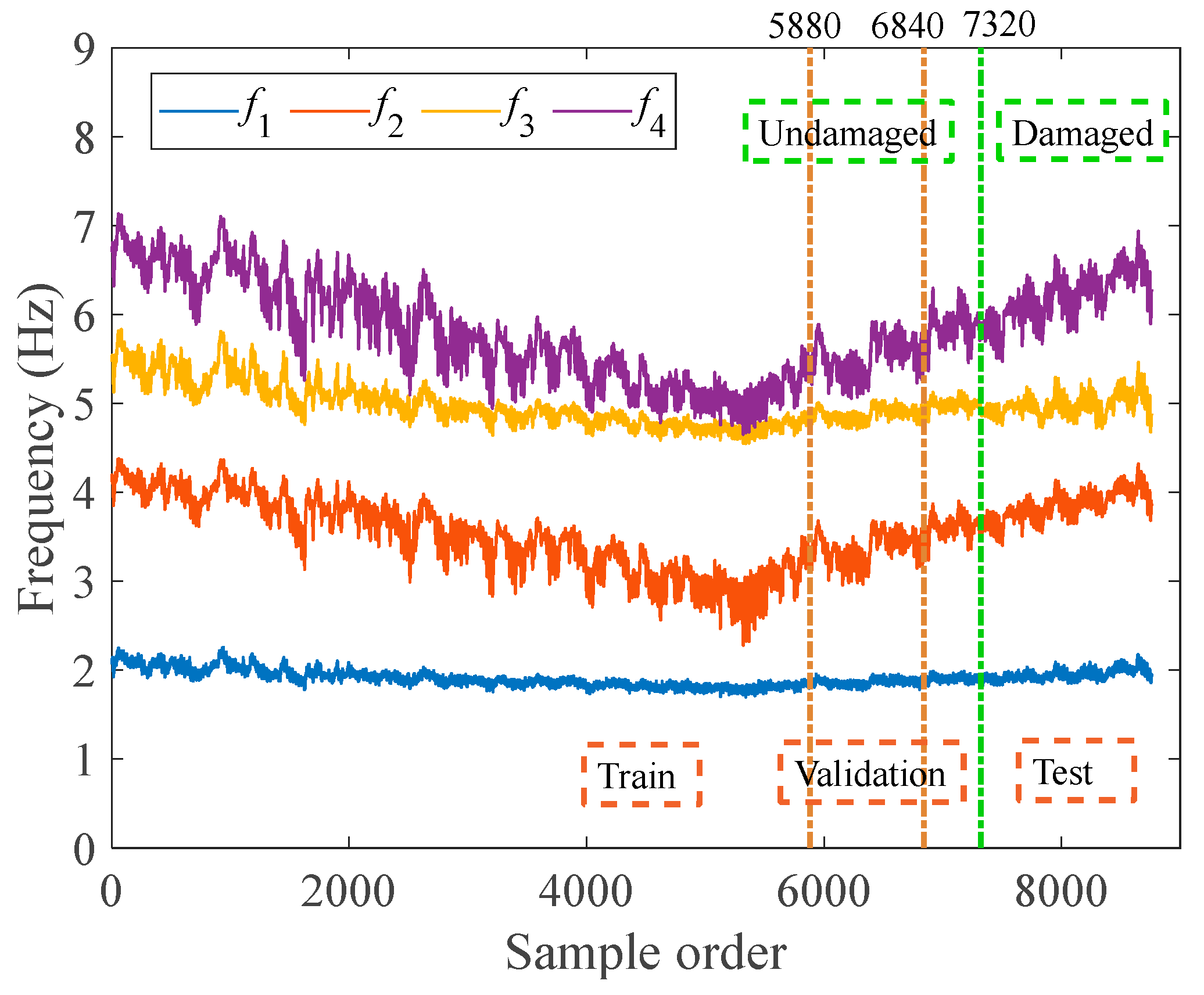
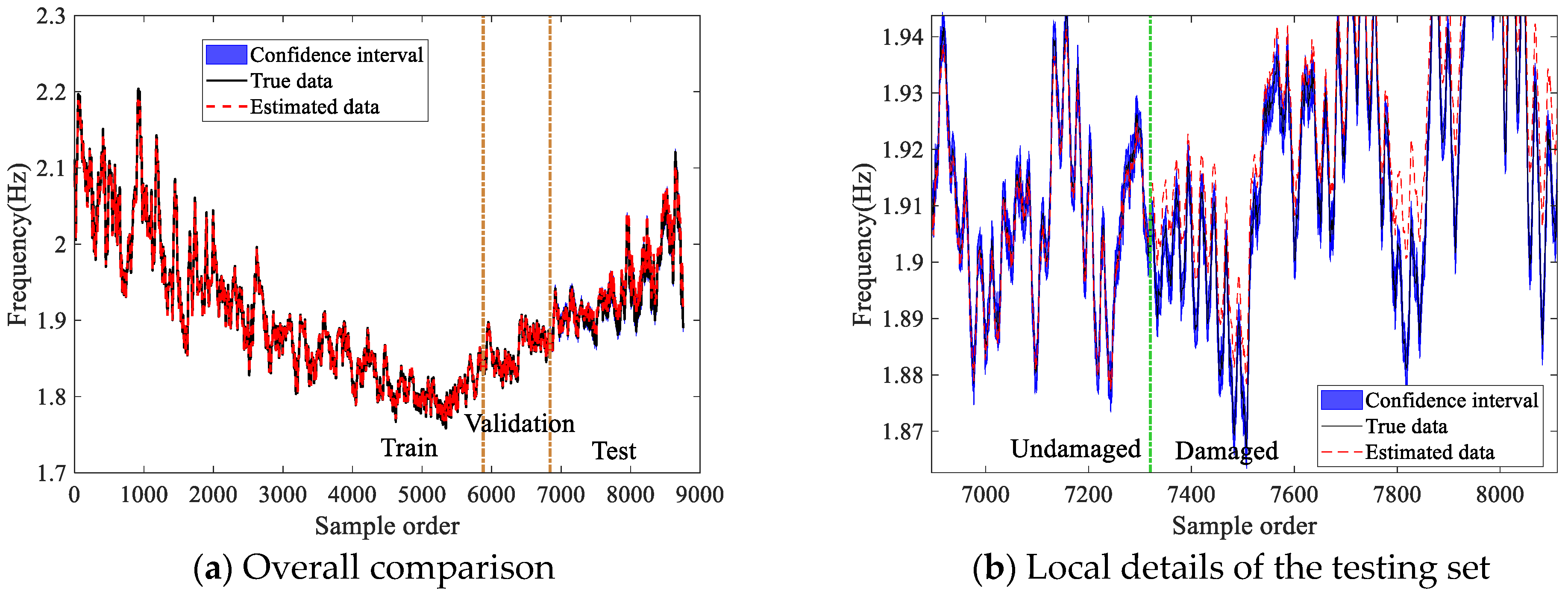
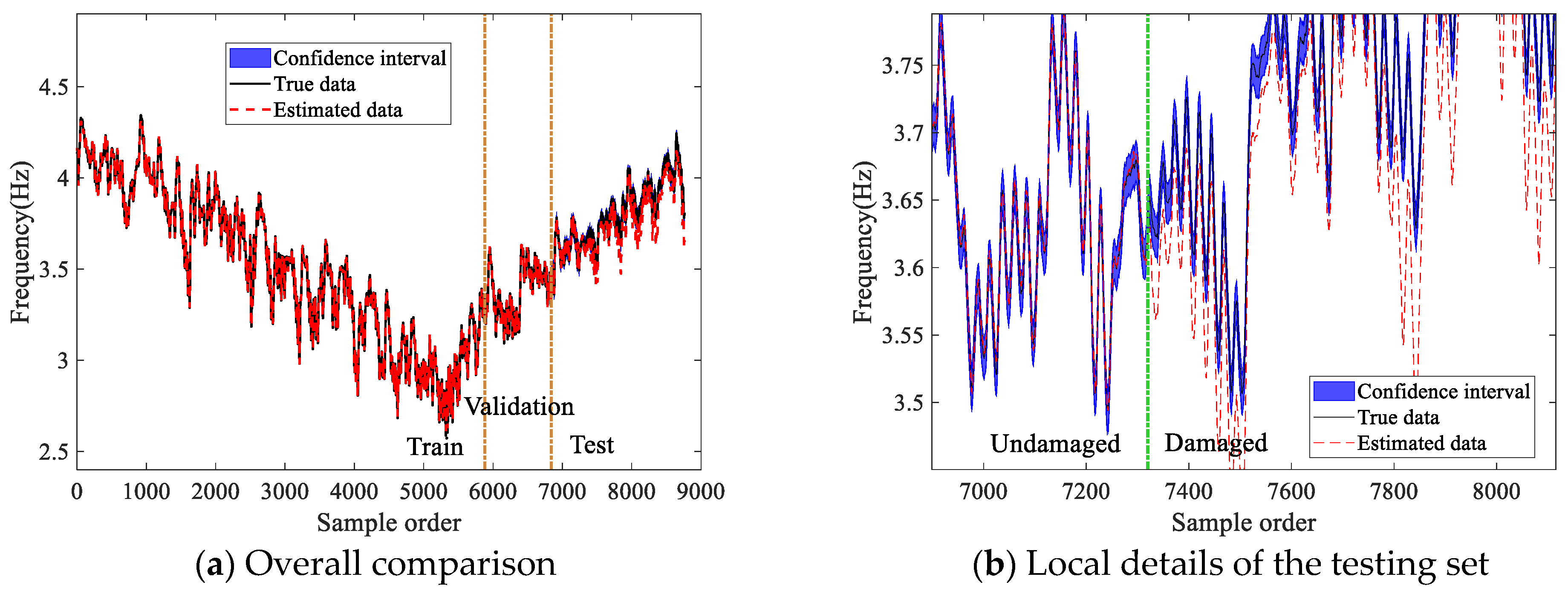


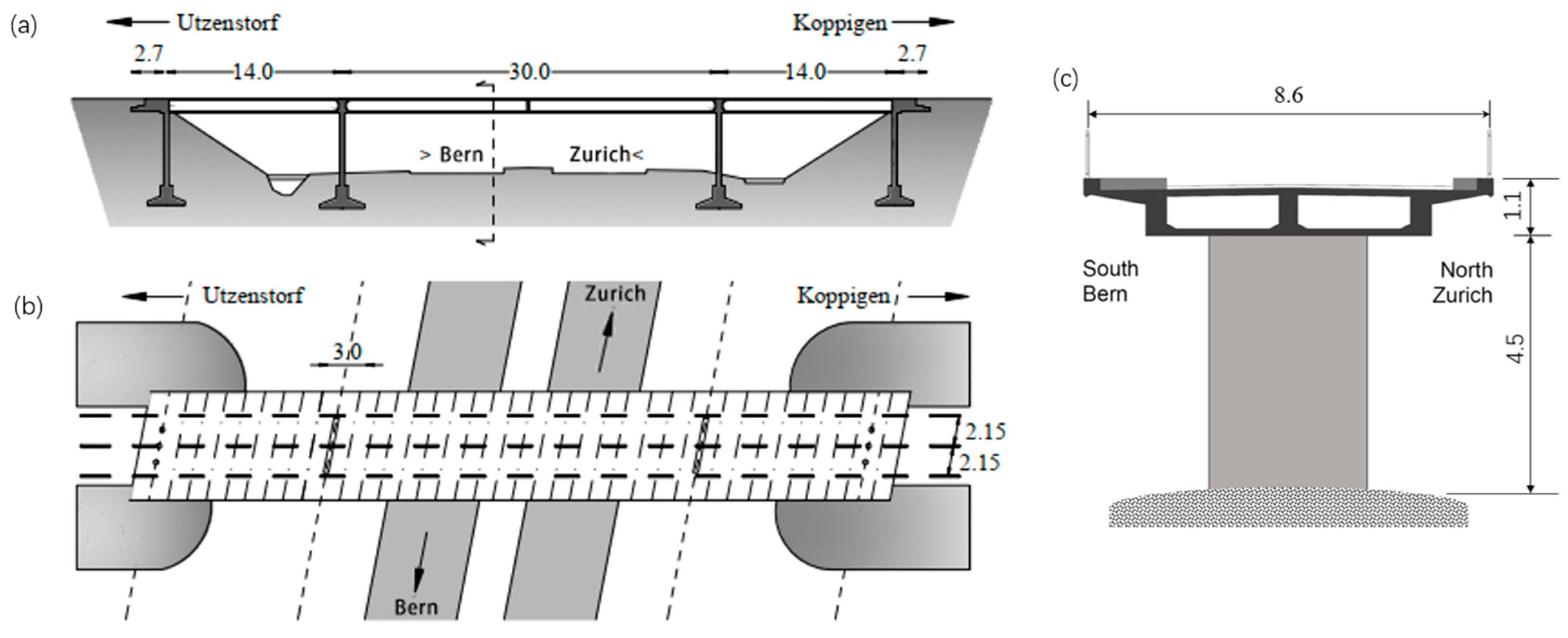


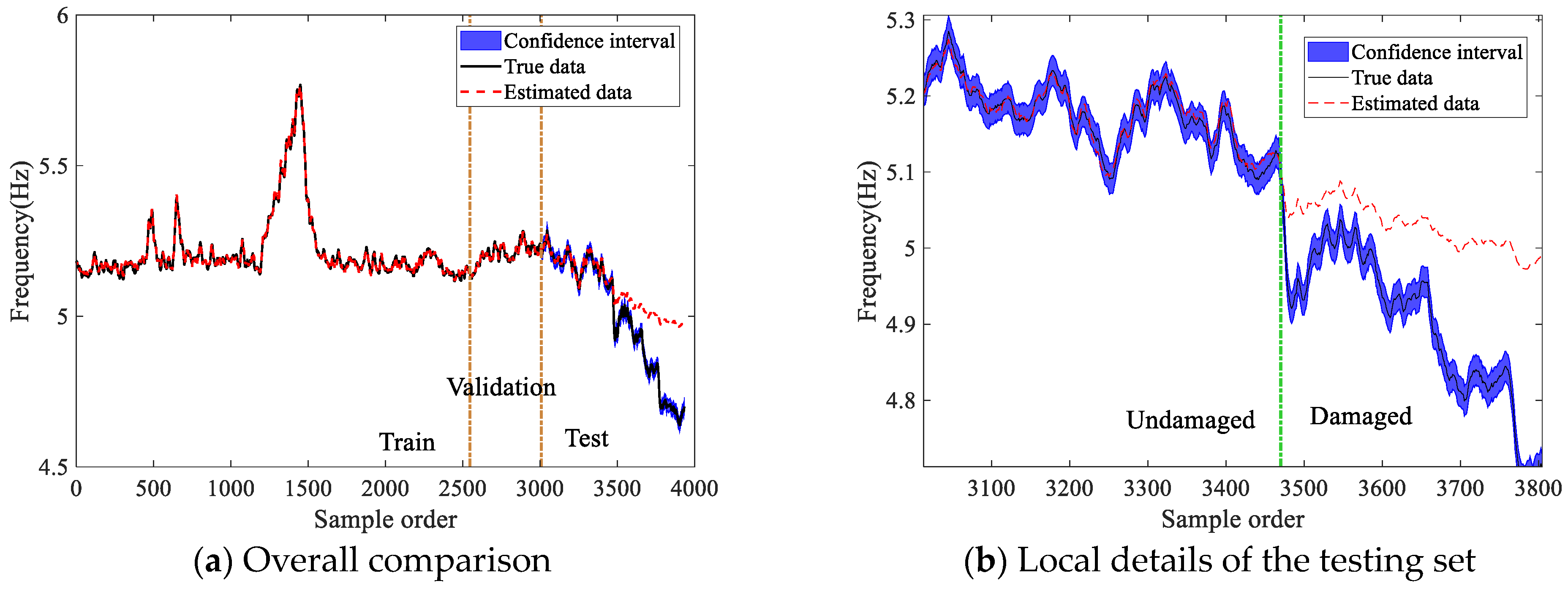


| Estimated Frequency | Damage Detection Rate (%) | |||
|---|---|---|---|---|
| Undamaged | State 1 | State 2 | State 3 | |
| f1 | 2.9 | 99.6 | 100 | 97.9 |
| f2 | 0.2 | 100 | 100 | 100 |
| f3 | 4.8 | 100 | 100 | 100 |
| f4 | 4.9 | 68.2 | 72.6 | 78.4 |
| Estimated Frequency | Damage Detection Rate (%) | |
|---|---|---|
| Undamaged State | Damaged State | |
| f1 | 5.0 | 81.4 |
| f2 | 4.9 | 98.3 |
| f3 | 0 | 98.3 |
| f4 | 3.4 | 95.1 |
Disclaimer/Publisher’s Note: The statements, opinions and data contained in all publications are solely those of the individual author(s) and contributor(s) and not of MDPI and/or the editor(s). MDPI and/or the editor(s) disclaim responsibility for any injury to people or property resulting from any ideas, methods, instructions or products referred to in the content. |
© 2025 by the authors. Licensee MDPI, Basel, Switzerland. This article is an open access article distributed under the terms and conditions of the Creative Commons Attribution (CC BY) license (https://creativecommons.org/licenses/by/4.0/).
Share and Cite
Pei, X.-Y.; Hou, Y.; Huang, H.-B.; Zheng, J.-X. A Deep Learning-Based Structural Damage Identification Method Integrating CNN-BiLSTM-Attention for Multi-Order Frequency Data Analysis. Buildings 2025, 15, 763. https://doi.org/10.3390/buildings15050763
Pei X-Y, Hou Y, Huang H-B, Zheng J-X. A Deep Learning-Based Structural Damage Identification Method Integrating CNN-BiLSTM-Attention for Multi-Order Frequency Data Analysis. Buildings. 2025; 15(5):763. https://doi.org/10.3390/buildings15050763
Chicago/Turabian StylePei, Xue-Yang, Yuan Hou, Hai-Bin Huang, and Jun-Xing Zheng. 2025. "A Deep Learning-Based Structural Damage Identification Method Integrating CNN-BiLSTM-Attention for Multi-Order Frequency Data Analysis" Buildings 15, no. 5: 763. https://doi.org/10.3390/buildings15050763
APA StylePei, X.-Y., Hou, Y., Huang, H.-B., & Zheng, J.-X. (2025). A Deep Learning-Based Structural Damage Identification Method Integrating CNN-BiLSTM-Attention for Multi-Order Frequency Data Analysis. Buildings, 15(5), 763. https://doi.org/10.3390/buildings15050763







